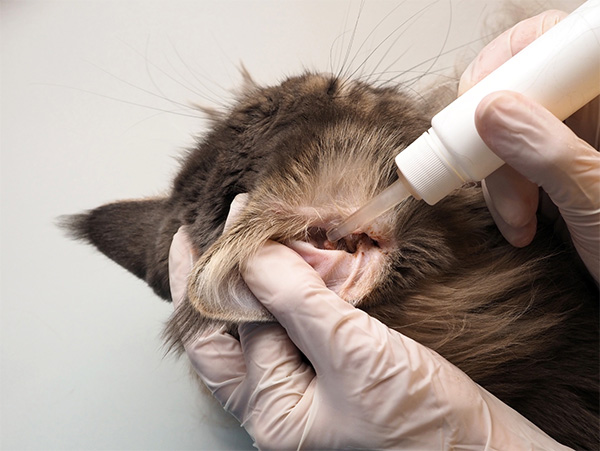Ear mites in cats are a common issue, causing discomfort and potentially leading to more severe health problems if left untreated. Knowing the causes, symptoms, and treatment options is crucial for keeping your cat healthy and comfortable. Here's a complete guide to ear mites in cats.
What Are Ear Mites?
Ear mites are tiny, eight-legged parasites that infest the ear canals of cats, feeding on ear wax and oils. The most common species, Otodectes cynotis, is highly contagious and spreads quickly between cats, other household pets, and wild animals. Cat ear mites cause irritation, inflammation, and symptoms like head shaking, scratching, and coffee grounds-like discharge. They can affect one or both ears, leading to suspected ear infections or bacterial complications.
Causes

Ear mites in cats are easily spread and typically transferred through direct contact with an infected animal. Kittens frequently acquire mites in cats from their mothers, while outdoor cats are at increased risk due to exposure to other infested animals or wild animals. Even one infected animal can spread mites, as their contagious nature allows them to transfer easily.
Mites can also survive temporarily in the environment, such as on cat's bedding, enabling indirect transmission. Indoor cats and newly adopted cats can contract ear mites if exposed to infested animals. Recognizing cats' symptoms early and using anti-parasitic medication can treat ear mites and prevent further complications, such as bacterial infection or severe ear irritation.
Symptoms
Ear mites in cats cause significant discomfort and often result in clinical signs that pet parents can observe. Cats' ear mites, particularly Otodectes cynotis mites, are highly contagious and can lead to severe irritation and suspected ear infections if untreated. Symptoms of ear mite infestations include:
Frequent scratching at the ears: Excessive scratching often leads to further irritation or severe skin damage.
Head shaking: A common response to mites moving within the ear canal.
Red, inflamed, or irritated ears: Visible inflammation of one or both ears.
Dark, crumbly discharge resembling coffee grounds: Waxy discharge in the outer ear is a hallmark symptom of ear disease caused by mites.
Unpleasant odor from the ears: This may indicate a bacterial infection or secondary ear disease.
Hair loss around the ears: Resulting from excessive scratching or severe irritation.
These symptoms occur due to the irritation caused by mites feeding and moving within the ear canal. If left untreated, ear mite infestations can result in secondary infections and cause permanent damage to the ears.
How to Diagnose

Accurately diagnosing ear mites in cats is crucial for timely treatment and to avoid potential complications. A visit to the veterinarian is required, as they have the tools and expertise to confirm the presence of mites in cats. The process typically involves:
Examination of the ear canal: Using an otoscope, the vet inspects the cat’s ears for mites, signs of inflammation, or clinical signs like ear irritation. Head shaking, scratching, or redness often indicates cat ear mites.
Microscopic analysis: A sample of ear discharge is collected and examined under a microscope to confirm the presence of mites, eggs, or an underlying cause such as a bacterial infection.
Diagnosing ear mites early is crucial to treat ear mites effectively and prevent further issues.
Treatment
Treating ear mites in cats requires a combination of steps to effectively eliminate these tiny parasites and manage related issues like ear irritation and secondary infections. Addressing ear mites promptly is essential, as their highly contagious nature can lead to further health concerns for your cat and other pets.
Ear Cleaning
Proper ear cleaning removes waxy discharge, debris, and the dark, crusty material associated with ear mites. This clears the cat's ear canal, improving the effectiveness of prescribed medication. A veterinarian should perform cleaning to prevent further irritation or damage to the outer ear.
Medication
Veterinarians prescribe antiparasitic medications, such as ear drops or topical treatments, to kill mites and address secondary infections caused by excessive scratching or bacterial overgrowth. In more serious cases, oral medication might be necessary. These treatments also eliminate mite eggs, breaking their life cycle. Treat all household pets to prevent re-infestation.
Follow-Up
A follow-up exam ensures that mites are fully eradicated, secondary infections are resolved, and your cat's ear canal is healing. Additional treatments may be prescribed for severe cases. Treating all exposed pets, washing bedding, and cleaning the environment help stop the mites’ spread.
Prevention

Preventive measures can help protect your cat from ear mites. These include:
Regularly cleaning your cat’s ears
Remove waxy discharge, debris, and any signs of ear irritation or ears dark crusty to prevent the ideal environment for mites in cats to thrive. Routine cleaning helps pet parents detect early signs of ear infections or suspected ear mite infestations.
Keeping your cat indoors
Indoor cats have a lower risk of contracting ear mites from infected animals, such as other cats or wild animals. Cats that spend time outdoors or encounter other household pets or newly adopted cats are at greater risk.
Using veterinarian-recommended preventive treatments
Anti-parasitic medication can prevent ear mites, kill mites if present, and break their life cycle. Preventive measures also reduce the risk of secondary bacterial infections from severe skin irritation caused by head shaking or scratching.
Scheduling routine veterinary check-ups
Regular check-ups help diagnose ear mites or other underlying causes of ear disease before they escalate. Vets can also prescribe medication for treating ear mites or advise on additional preventive care tailored to your cat.
FAQs
How Long Does It Take to Get Rid of Ear Mites?
With appropriate treatment, ear mites in cats can be eradicated in just a few weeks. Veterinarians often prescribe anti-parasitic medication to treat ear mites and ensure all mites, including eggs that hatch during treatment, are destroyed. It's crucial to follow the vet's instructions closely and complete the entire treatment plan to tackle the root cause and avoid the need for additional treatments.
Are Ear Mites Contagious to Other Cats, Pets, or Humans?
Cat ear mites are highly contagious and can spread rapidly between cats, dogs, and even wild animals. Just one infected animal can transmit mites through direct contact or shared items, like a cat's bedding. While rare, humans may also experience mild irritation from mites in cats. To prevent ear mites, pet parents should treat all affected pets, practice good hygiene, and limit exposure to infected animals. This includes monitoring indoor cats or a newly adopted cat for cats’ symptoms like head shaking, scratching, or ear irritation. Consult a vet promptly for clinical signs to prevent complications like bacterial infection.
